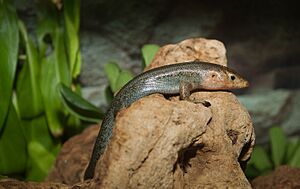Bermuda skink facts for kids
Quick facts for kids Bermuda skink |
|
|---|---|
 |
|
| Conservation status | |
| Scientific classification | |
| Genus: |
Plestiodon
|
| Species: |
longirostris
|
| Synonyms | |
|
Eumeces longirostris |
|
The Bermuda skink is a special kind of lizard found only on the island of Bermuda. It's also called the longnose skink or Bermuda rock lizard. This small lizard is very rare and is considered critically endangered. It's the only land animal with a backbone (a vertebrate) that lives naturally only in Bermuda. Adult Bermuda skinks are about 8 cm (3.1 in) long, not including their tail.
Contents
What Does the Bermuda Skink Look Like?
Adult Bermuda skinks are usually dark brown or black on their backs. Their bellies are a light pink or gray color. Young skinks are lighter and have black stripes on their sides. These stripes slowly disappear as they get older. Female skinks might keep their stripes longer than males. Adult male skinks have bigger heads than females. Baby skinks, called hatchlings, have bright blue tails. All Bermuda skinks have salmon-orange cheeks and throats.
Where Do Bermuda Skinks Live?
Bermuda skinks mostly live in rocky areas along the coast. They like places where there are lots of rocks and crevices to hide in.
What Do Bermuda Skinks Eat?
These skinks are not picky eaters. They mostly eat small invertebrates. This includes insects like cockroaches and woodlice. They also eat small land crustaceans, which are like tiny crabs or shrimp that live on land.
When Are Bermuda Skinks Active?
Bermuda skinks are more active during the summer months. However, they do not hibernate (go into a deep sleep for winter). Bermuda has mild winters with no frost. This means the skinks can stay active all year long.
Where Can You Find Bermuda Skinks?
The Bermuda skink lives only in Bermuda. You can find them mainly on some of the smaller islands. They also live in special nature reserves on the main island. Their populations are often separated into small, isolated groups.
Why Are Bermuda Skinks Endangered?
The Bermuda skink is listed as critically endangered on the IUCN Red List. This means they are at a very high risk of disappearing forever. Several things threaten these unique lizards.
Loss of Homes
One big threat is habitat destruction. This happens when their natural homes are damaged or removed. Buildings, roads, and other human activities can destroy the rocky coastal areas where skinks live.
Dangerous Predators
Another major problem is predators that humans have brought to Bermuda. These animals hunt and eat the skinks. Some of these predators include cats, rats, American crows, chickens, great kiskadees, yellow-crowned night herons, cane toads, and anoles.
Human Trash Dangers
Human litter also poses a big risk. Bermuda skinks have tiny claws on their feet. But they don't have friction pads like some other lizards. This means they can't climb well on smooth surfaces. If a skink falls into an empty glass bottle or soda can, it can't climb out. It might then starve, get too hot, or become dehydrated and die.
How Are We Protecting Bermuda Skinks?
The Bermuda skink is a protected species. It is listed under Bermuda's 2003 Protected Species Act. This law helps to keep them safe.
Chester Zoo in the United Kingdom is also helping. They have a special captive breeding program. This program tries to breed Bermuda skinks in a safe environment. The goal is to increase their numbers and help save the species.


